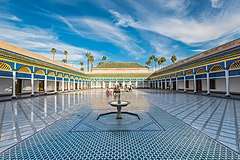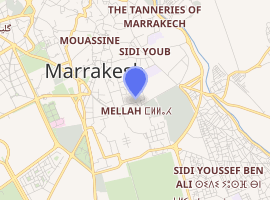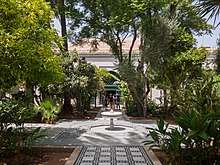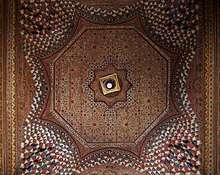Bahia Palace
The Bahia Palace (Arabic: قصر الباهية, Berber languages: ⵜⴰⴳⴰⴷⵉⵔⵜ ⵏ Иⴱⴰⵀⵢⴰ) is a late 19th-century palace in Marrakesh, Morocco. The palace was first begun by Si Musa, grand vizier of Alaouite sultan Muhammad ibn Abd al-Rahman, in 1859 and then continued and expanded by his son Si Ba Ahmed ibn Musa, grand vizier of Sultan Moulay Abdelaziz between 1894 and 1900.[1][2][3] Today it is a well-known historic monument and tourist attraction in the city.[4][5]
| Bahia Palace | |
|---|---|
 The Grand Courtyard of the Bahia Palace | |

| |
| General information | |
| Type | palace |
| Architectural style | Moroccan, Islamic |
| Location | Marrakesh, Morocco |
| Coordinates | 31°37′17.73″N 7°58′56.03″W |
| Construction started | 1859 (or 1860s) |
| Completed | 1900 |
| Design and construction | |
| Architect | Muhammad ibn Makki al-Misfiwi |
History
19th century construction
Si Musa was descended from a family of black slaves which served the Moroccan makhzen (royal government) and reached the highest offices in the country.[6][7] He was first hajib (similar to a chamberlain) then grand vizier under Muhammad ibn Abd al-Rahman, who reigned from 1859 to 1873. He began the construction of the palace in 1859 and continued during the 1860s.[1][8] Today, the "Grand Riad" or large riad garden and its adjoining rooms in the northern part of the palace date from Si Musa's time and are also consequently known as the Dar Si Moussa.[3][9][10] The two grand chambers on the east and west sides of the garden contain an inscription which dates their construction to 1866-67.[10]
Ba Ahmed ibn Musa (known simply as Ba Ahmed) was hajib to Sultan Moulay Hassan and, upon the latter's death, ensured his son Abdelaziz's accession to the throne in 1894, earning him a promotion to grand vizier.[11][10] As Abdelaziz was only sixteen, Ba Ahmed became the effective ruler of Morocco until his own death from disease in 1900.[12][3] He progressively expanded his father's palace throughout these years as grand vizier (1894-1900), adding to it piece by piece as new land became available for purchase.[3][10] During his tenure, he was also supported by his two brothers Si Sa'id and Idris (who passed away with him in 1900).[3][10] Si Sa'id built his own palace north of here during that time, the Dar Si Said, which today serves as a museum.[3][13]
Ba Ahmed is responsible for constructing most of the Bahia Palace's southern parts, which included various smaller courtyards and riad gardens.[3] On the east side of this palace complex he also created a vast private park and garden, complete with a central water basin and an access point via a bridge over the adjacent street linking it to the palace.[10] His architect was a man named Muhammad ibn Makki al-Misfiwi, originally from Safi, who was born in 1857 and died in 1926.[10][3] The palace's growth overtook much of the previously existing neighbourhood north of the Mellah and resulted in major changes in the local street layout.[10] The growing palace housed Ba Ahmed's servants (including his own slaves) and his harem (private family residence), and the name al-Bahia (Arabic: الباهية), meaning "the Brilliant", was reportedly the name of his favourite wife.[8][1] The entire palace was built on one level, possibly as Ba Ahmed's own physique (which was described as stout and obese) made it more difficult for him to go up and down stairs.[10]
20th century to present day
After Ba Ahmed's death his palace became royal property. Mere hours after his passing, Sultan Abdelaziz (who subsequently took full power over the country) reportedly ordered the palace to be looted for valuable items.[10][9] In 1908 Madani el-Glaoui, brother of Thami el-Glaoui, took control of the palace and used it to entertain foreign guests.[8] He added an upper floor for the first time to some parts of the palace.[10]:545 Then, in 1912, after the installation of the French Protectorate in Morocco, the palace was converted into the residence of the French resident-general (Lyautey) in the city.[1][8] After Moroccan independence, the palace was again used as a royal residence for King Mohammed V before being transferred to the Moroccan Ministry of Culture under King Hassan II, which turned it into a tourist attraction.[1]
Today the palace is one of the most visited tourist attractions in Morocco; the government counted 410,141 visitors from January to April 2019, more than any other heritage site in the country.[14] The palace is occasionally still used by the King of Morocco to receive foreign dignitaries or host events.[1][9]
Architecture
Layout
The palace's labyrinthine layout, which does not reveal a clear unified plan, is due to the fact that it was expanded in a piecemeal fashion in different stages over many years.[15][9][16] It comprises a number of inner courtyards and riad gardens (interior gardens with a symmetrical four-part division), around which are arranged various rooms and chambers. The main palace complex today covers almost 2 hectares.[3]
The palace is entered via a horseshoe-arch doorway from the main street, beyond which a long garden path leads to the palace.[17] A minor courtyard leads into the Small Riad (Petit Riad), a square courtyard garden divided by walkways along its two central axes and surrounded by richly decorated galleries and chambers.[17][8][3] One of the chambers was Ba Ahmed's diwan or Council Chamber.[16] A second floor apartment above this riad was added by Madani el-Glaoui after Ba Ahmed's death.[8]
East of the Small Riad is a small inner courtyard (sometimes simply called the "Small Courtyard") surrounded by ornate chambers.[16] East of this is the Grand Courtyard or Large Courtyard (also known in French as the Cour d'Honneur), the most impressive part of the palace.[10][8] Measuring 50 by 30 meters, it is paved with Italian Carrara marble and surrounded by an elegant and colourful wooden gallery.[10][8] These galleries give access to some 80 rooms which are believed to have been part of Ba Ahmed's harem and the residences of his concubines.[16] At the east end of this courtyard is a grand hall (lknown as the Salle d'Honneur in French), measuring 20 by 8 meters and featuring a high ceiling with some of the best painted decoration in the palace.[10] An inscription dates the construction of this chamber to 1896-1897, which was probably the last major expansion of the palace.[10]:544 West of the Grand Courtyard (more or less between the Small Courtyard to the south and the Great Riad to the north) is a private apartment built by Ba Ahmed in 1898 for his first wife, Lalla Zaynab.[16]
North of the Grand Courtyard areas is another vast courtyard known as the Grand Riad or Large Riad.[8] Along with its adjoining rooms, it is the oldest part of the palace and dates from the time of Ba Ahmed's father, Si Musa.[3][9][10] The courtyard is occupied, as its name implies, by a very large riad garden which is still planted with trees from the 19th century.[10] The garden is flanked to the east and the west by two grand halls with excellent decoration and an inscription which dates their construction to 1866-67.[10]
Further east, beyond the main palace, are the remains of a series of gardens and parks created by Ba Ahmed. Among other elements, they contained a large water basin.[10] On the south side of the palace are other annexes includes stables and a mosque with a minaret.[10]
Decoration
The palace is most famous for its decoration.[8][17][9] Its walls feature stucco carved with Arabic inscriptions, geometric patterns, arabesques, and muqarnas. Its floors are paved with marble and zellij tiles. Among its most famous elements are the cedar-wood ceilings painted with colourful floral patterns, along with the carved and painted wooden canopies of major doorways.[8][9] The materials for this decoration were imported by Ba Ahmed from all over Morocco, including marble from Meknes (possibly from former Moroccan royal palaces), cedar wood from the Middle Atlas, and tiles from Tetouan.[10][9] Artisans from all across the country were also employed for the job.[10]
Gallery
Entrance of the palace
- Entrance to the palace grounds
- Garden path leading from the gate to the palace
 Second gateway, the entrance to the main palace
Second gateway, the entrance to the main palace Minor courtyard at the entrance of the main palace
Minor courtyard at the entrance of the main palace
The Small Riad
.jpg) The courtyard and garden of the Small Riad
The courtyard and garden of the Small Riad.jpg) The gallery around the courtyard
The gallery around the courtyard.jpg) Stucco decoration in the courtyard, including muqarnas sculpting
Stucco decoration in the courtyard, including muqarnas sculpting Sculpted and painted wooden ceiling in one of the rooms around the courtyard
Sculpted and painted wooden ceiling in one of the rooms around the courtyard.jpg) A fireplace in one of the rooms, with painted wood and zellij decoration
A fireplace in one of the rooms, with painted wood and zellij decoration Hall or salon between the Small Riad and the Small Courtyard to the east
Hall or salon between the Small Riad and the Small Courtyard to the east.jpg) Detail of the painted ceiling
Detail of the painted ceiling
The Small Courtyard
 The "Small Courtyard" of the palace (located between the Small Riad and the Grand Courtyard)
The "Small Courtyard" of the palace (located between the Small Riad and the Grand Courtyard).jpg) Example of "muqarnas" or "lambrequin" arches in the palace
Example of "muqarnas" or "lambrequin" arches in the palace.jpg) Sculpted and painted wooden ceiling in one of the rooms around the courtyard
Sculpted and painted wooden ceiling in one of the rooms around the courtyard.jpg) Decorated ceiling in another room around the courtyard
Decorated ceiling in another room around the courtyard.jpg) Details of the decorated ceiling, including sculpted and painted stucco just below the wooden ceiling
Details of the decorated ceiling, including sculpted and painted stucco just below the wooden ceiling.jpg) Details of the painted wood ceiling
Details of the painted wood ceiling
The Grand Courtyard
 The Grand Courtyard
The Grand Courtyard The Grand Courtyard (looking west)
The Grand Courtyard (looking west) The gallery around the courtyard
The gallery around the courtyard Painted ceiling under the gallery
Painted ceiling under the gallery A glimpse of the minaret of the palace mosque, seen from the Grand Courtyard
A glimpse of the minaret of the palace mosque, seen from the Grand Courtyard
Private apartment of Ba Ahmed's wife
 The main hall of the apartment
The main hall of the apartment Painted ceiling over the hall
Painted ceiling over the hall.jpg) Painted and sculpted ceiling in one of the side rooms
Painted and sculpted ceiling in one of the side rooms
The Grand Riad (Dar Si Moussa)
 Courtyard and garden of the Grand Riad
Courtyard and garden of the Grand Riad Wooden ceiling with painted and carved muqarnas decoration at the entrance of the Grand Riad
Wooden ceiling with painted and carved muqarnas decoration at the entrance of the Grand Riad.jpg) Decorative alcove on the northern side of the garden
Decorative alcove on the northern side of the garden VIew towards one of the chambers adjoining the riad
VIew towards one of the chambers adjoining the riad.jpg) Doorway of the chambers adjoining the garden
Doorway of the chambers adjoining the garden Decorated alcove in one of the chambers adjoining the garden
Decorated alcove in one of the chambers adjoining the garden
References
| Wikimedia Commons has media related to Bahia Palace. |
- "Historique". Palais Bahia (in French). Retrieved 2020-06-04.
- Marçais, Georges (1954). L'architecture musulmane d'Occident. Paris: Arts et métiers graphiques. p. 397.
- Wilbaux, Quentin (2001). La médina de Marrakech: Formation des espaces urbains d'une ancienne capitale du Maroc. Paris: L'Harmattan. p. 289. ISBN 2747523888.
- Benabou, Mohammed Amine (2019-05-13). "Morocco's Heritage Sites Attract Over 1 Million Visitors in 26% Increase". Morocco World News. Retrieved 2020-06-18.
- "Bahia Palace | Marrakesh, Morocco Attractions". Lonely Planet. Retrieved 2020-06-18.
- Rivet, Daniel (2012). Histoire du Maroc: De Moulay Idris à Mohammed VI. Fayard.
- El Hamel, Chouki (2014). Black Morocco: A History of Slavery, Race, and Islam. Cambridge University Press.
- "Bahia Palace | Marrakesh, Morocco Attractions". Lonely Planet. Retrieved 2020-06-04.
- "Bahia Palace". Archnet. Retrieved 2020-06-04.
- Deverdun, Gaston (1959). Marrakech: Des origines à 1912. Rabat: Éditions Techniques Nord-Africaines.
- C.R., Pennell (2000). Morocco Since 1830: A History. New York University Press. p. 108.
- "Abd al-Aziz | sultan of Morocco". Encyclopedia Britannica. Retrieved 2020-06-04.
- "Dar Si Said | Marrakesh, Morocco Attractions". Lonely Planet. Retrieved 2020-06-04.
- "Plus d'un million de visiteurs des sites du patrimoine du Royaume au 1ertrimestre de l'année. – Ministère de la culture" (in French). Retrieved 2020-06-18.
- Wilbaux, Quentin (2001). La médina de Marrakech: Formation des espaces urbains d'une ancienne capitale du Maroc. Paris: L'Harmattan. p. 289. ISBN 2747523888.
- "🏛️ The Bahia Palace, Marrakech: History, Opening times, Entrance fee". Travelguide Marrakech. Retrieved 2020-06-04.
- "Le Palais Bahia". Palais Bahia (in French). 2020-01-01. Retrieved 2020-06-04.